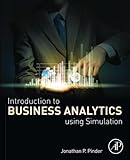Introduction to Business Analytics Using Simulation / Jonathan P. Pinder
Material type: TextPublication details: London Academic Press (An Imprint of Elsevier) 2017Description: xiii, 434p. : ill. ; 23cmISBN:
TextPublication details: London Academic Press (An Imprint of Elsevier) 2017Description: xiii, 434p. : ill. ; 23cmISBN: - 9780128104842
- 23rd Ed. 658.472 PIN
| Item type | Current library | Collection | Call number | Status | Notes | Date due | Barcode | |
|---|---|---|---|---|---|---|---|---|
| Reference Book | VIT-AP General Stacks | Reference | 658.472 PIN (Browse shelf(Opens below)) | Not for loan | MGT | 019433 |
It includes Appendix and Index Pages.
Introduction to Business Analytics Using Simulation employs an innovative strategy to teach business analytics. It uses simulation modeling and analysis as mechanisms to introduce and link predictive and prescriptive modeling. Because managers can't fully assess what will happen in the future, but must still make decisions, the book treats uncertainty as an essential element in decision-making.
Its use of simulation gives readers a superior way of analyzing past data, understanding an uncertain future, and optimizing results to select the best decision. With its focus on the uncertainty and variability of business, this comprehensive book provides a better foundation for business analytics than standard introductory business analytics books. Students will gain a better understanding of fundamental statistical concepts that are essential to marketing research, Six-Sigma, financial analysis, and business analytics.
Key Features
Winner of the 2017 Textbook and Academic Authors Association (TAA) Most Promising New Textbook Award
Teaches managers how they can use business analytics to formulate and solve business problems to enhance managerial decision-making
Explains the processes needed to develop, report, and analyze business data
Describes how to use and apply business analytics software
Readership
Upper-division undergraduates and graduate students worldwide working on business decision-making. Prerequisite: statistics
Table of Contents
Preface
Acknowledgments
Chapter 1: Business analytics is making decisions
Abstract
Introduction
Chapter 2: Decision-making and simulation
Abstract
Introduction
Chapter 3: Decision Trees
Abstract
Introduction
Chapter 4: Probability: measuring uncertainty
Abstract
Introduction
Chapter 5: Subjective Probability Distributions
Abstract
Introduction
Chapter 6: Empirical probability distributions
Abstract
Introduction
Chapter 7: Theoretical probability distributions
Abstract
Introduction
Chapter 8: Simulation accuracy: central limit theorem and sampling
Abstract
Introduction
Chapter 9: Simulation fit and significance: chi-square and ANOVA
Abstract
Introduction
Chapter 10: Regression
Abstract
Introduction
Chapter 11: Forecasting
Abstract
Introduction
Appendix 1: Summary of simulation
Appendix 2: Statistical tables
Index
There are no comments on this title.

